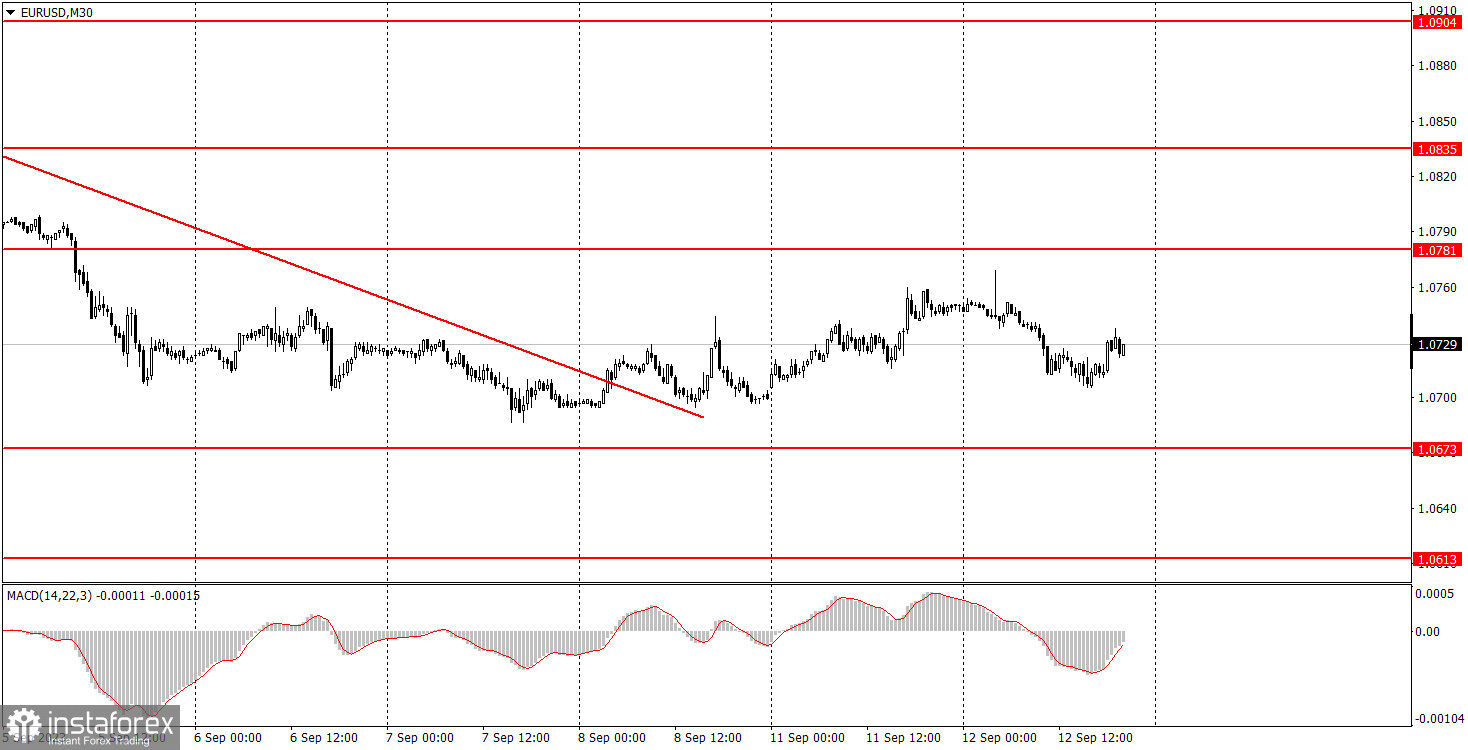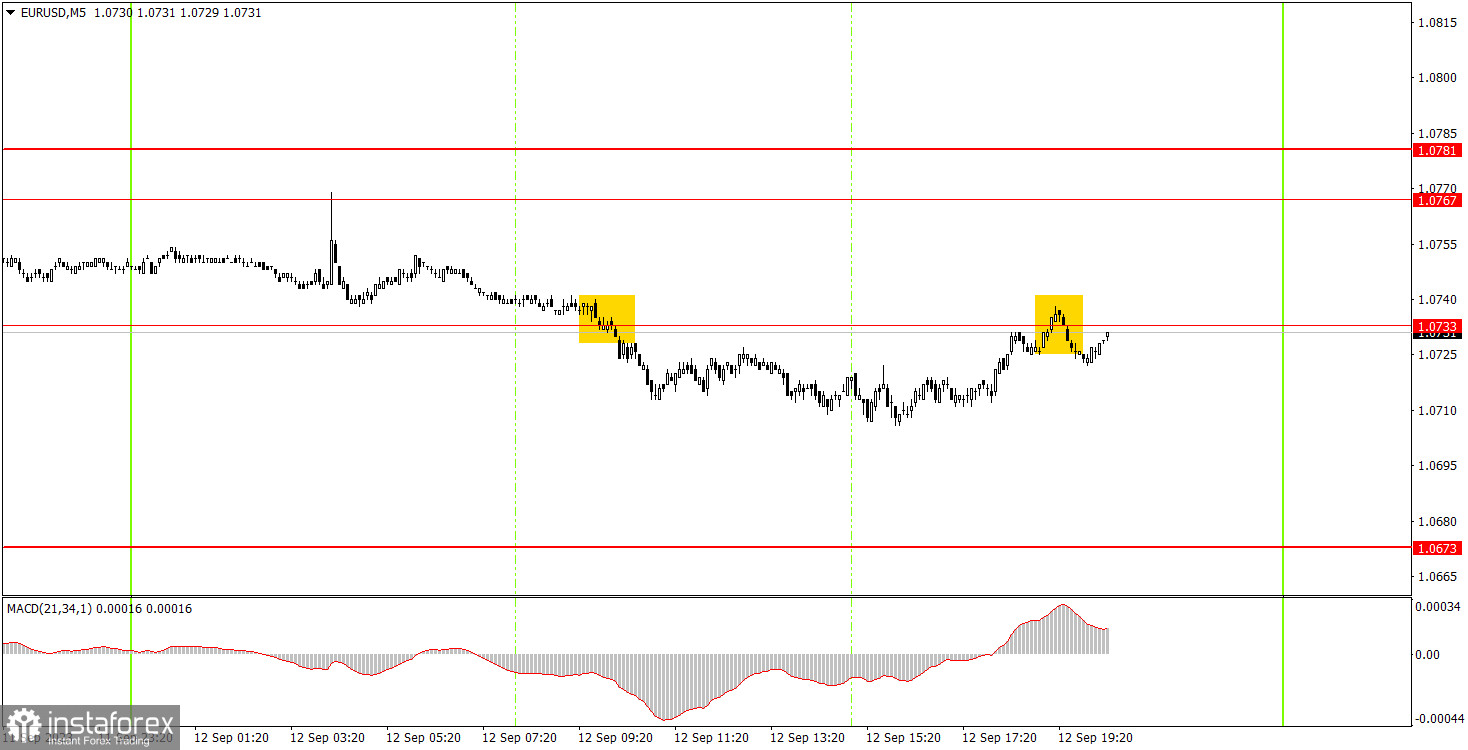Analyzing Tuesday's trades:
EUR/USD on 30M chart

EUR/USD experienced very low volatility on Tuesday. It traded by a total of 65 pips, which doesn't seem small at first glance. However, if we look at the 5-minute chart, it becomes clear that about a third of this movement occurred during the Asian trading session. So in general, volatility was quite weak, with the pair mostly falling throughout the day and remaining very close to its local lows.
In terms of macroeconomic events, the most noteworthy ones were the ZEW Economic Sentiment. Both the eurozone and Germany showed figures below zero, indicating that there is no improvement in the situation. We don't know if the market even noticed these reports since there were no significant market reactions.
EUR/USD on 5M chart

Only two trading signals were formed on the 5-minute chart. At the beginning of the European trading session, the pair broke below the level of 1.0733 and managed to fall by another 16 pips over the next 6-7 hours. This was enough to set a breakeven stop loss for the short position, but nothing more. In the middle of the US trading session, the pair returned to the level of 1.0733, but we have yet to see a signal. Therefore, beginners could have opened one position that neither resulted in a loss or profit.
Trading tips on Wednesday:
The trend has temporarily ended on the 30-minute chart, and a corrective phase has begun. Despite breaking the trendline, the euro doesn't have any strong bullish factors it can use. A continued bearish movement is anticipated. Medium-term projections are aligned with this trend, irrespective of the macroeconomic and fundamental backdrop. However, this week's background will be strong enough, so a bullish correction is possible. The key levels on the 5M chart are 1.0517-1.0533, 1.0607-1.0613, 1.0673, 1.0733, 1.0767-1.0781, 1.0835, 1.0871, 1.0901-1.0904, 1.0936, 1.0971-1.0981. A stop loss can be set at a breakeven point as soon as the price moves 15 pips in the right direction. On Wednesday, the eurozone will release a secondary report on industrial production, which traders will likely brush off. On the other hand, a crucial inflation report will be released in the US, which could have a strong impact on all currency pairs involving the dollar.
Basic trading rules:
1) The strength of the signal depends on the time period during which the signal was formed (a rebound or a break). The shorter this period, the stronger the signal.
2) If two or more trades were opened at some level following false signals, i.e. those signals that did not lead the price to Take Profit level or the nearest target levels, then any consequent signals near this level should be ignored.
3) During the flat trend, any currency pair may form a lot of false signals or do not produce any signals at all. In any case, the flat trend is not the best condition for trading.
4) Trades are opened in the time period between the beginning of the European session and until the middle of the American one when all deals should be closed manually.
5) We can pay attention to the MACD signals in the 30M time frame only if there is good volatility and a definite trend confirmed by a trend line or a trend channel.
6) If two key levels are too close to each other (about 5-15 pips), then this is a support or resistance area.
How to read charts:
Support and Resistance price levels can serve as targets when buying or selling. You can place Take Profit levels near them.
Red lines are channels or trend lines that display the current trend and show which direction is better to trade.
MACD indicator (14,22,3) is a histogram and a signal line showing when it is better to enter the market when they cross. This indicator is better to be used in combination with trend channels or trend lines.
Important speeches and reports that are always reflected in the economic calendars can greatly influence the movement of a currency pair. Therefore, during such events, it is recommended to trade as carefully as possible or exit the market in order to avoid a sharp price reversal against the previous movement.
Beginners should remember that every trade cannot be profitable. The development of a reliable strategy and money management are the key to success in trading over a long period of time.





















